Archive for the ‘China’s Museums’ Category
Shaanxi History Museum
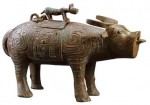 The Shaanxi History Museum is situated on Yan Ta Road in Xi’an City, Shaanxi Province. It covers 65,000 square meters, with a building area of 60,000 square meters. The newly built modern building recreates Tang-dynasty architecture and successfully symbolizes the great extent of Shaanxi history and its remarkable culture.
The Shaanxi History Museum is situated on Yan Ta Road in Xi’an City, Shaanxi Province. It covers 65,000 square meters, with a building area of 60,000 square meters. The newly built modern building recreates Tang-dynasty architecture and successfully symbolizes the great extent of Shaanxi history and its remarkable culture.
Exhibited in the main exhibition hall are 2,700 works of art, with an  exhibition line that extends 2,300 meters. The exhibition space is divided into an introductory hall, permanent exhibitions, special exhibitions, and temporary exhibitions, as well as one that has been named the National Painting Hall.
exhibition line that extends 2,300 meters. The exhibition space is divided into an introductory hall, permanent exhibitions, special exhibitions, and temporary exhibitions, as well as one that has been named the National Painting Hall.
The Museum’s permanent exhibition primarily displays Shaanxi’s ancient history. Representative pieces from all periods have been selected to show the development of civilization in this region. The exhibition space of this display is 4,600 square meters. It includes three exhibition rooms, divided into seven parts (Prehistory, Zhou, Qin, Han, Wei-Jin-North and South dynasties, Sui-Tang, and Song-Yuan-Ming-Qing). The superlative 2,000 selected objects include: painted Neolithic ceramics reflecting early people’s living conditions and their pursuit of vibrant art forms, bronzes reflecting the rise of Zhou people, bronze weapons including swords, and statuary of horses and soldiers, reflecting the way in which Qin unified all under heaven, Tang-dynasty gold and silver objects and Tang sancai (tri-colored pottery of Tang dynasty) ceramics, reflecting the most flourishing period of feudal glory. All of this is accompanied by models of archaeological sites, and drawings, and photographs. These works systematically exhibit the ancient history of Shaanxi from 150,000 years ago to the year 1840. Since several historical periods all based their capitals on Shaanxi territory, such as Zhou, Qin, Western Han, Sui and Tang, the exhibits emphasize these periods and these places. This not only expresses the extent of culture in ancient Shaanxi, it also displays the highest level of cultural development of China’s social economy.
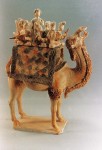 The temporary exhibits hall, located on the east side of the museum, has had a variety of exhibitions including Tang-tomb wall paintings, that is to say 39 of the actual paintings. Shaanxi’s wall murals of this kind rank first in the entire country. They are fluid in concept and line, they have marvelous details, and they both depict Tang customs and are superb works of art.
The temporary exhibits hall, located on the east side of the museum, has had a variety of exhibitions including Tang-tomb wall paintings, that is to say 39 of the actual paintings. Shaanxi’s wall murals of this kind rank first in the entire country. They are fluid in concept and line, they have marvelous details, and they both depict Tang customs and are superb works of art.
The special exhibition hall is located on the west side of the museum. Its first two exhibitions were a Shaanxi bronzes exhibit (260 were on display) and a Shaanxi-through-the-dynasties terracotta masterpieces exhibit (341 objects were exhibited). The area of this hall is around 2,600 square meters.
The Shaanxi History Museum contains 115,000 objects in its collections. The more representative of these include bronzes, Tang-dynasty tomb wall paintings, terracotta statuary, ceramics (pottery and porcelain), construction materials through the dynasties, Han and Tang bronze mirrors, and coins and currency, calligraphy, rubbings, scrolls, woven articles, bone articles, wooden and lacquer and iron and stone objects, seals, as well as  some contemporary cultural relics and ethnic objects.
some contemporary cultural relics and ethnic objects.
Address: Shaanxi Province, Xi’an City, Yanta Road, #70
Shanghai Museum
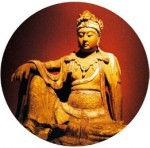 The scope, depth and quality of its collections, and the striking architecture and use of modern technology make the Shanghai Museum one of the most famous if not the most famous in China. It covers an area of 38,000 square meters, with a scale that surpasses the old museum several fold. The exterior of the museum utilizes the shape of an ancient bronze ding, specifically a Chen ding, with its rather archaic flavor. The structure and materials of the entire building, however, are an accomplishment of the most modern technology.
The scope, depth and quality of its collections, and the striking architecture and use of modern technology make the Shanghai Museum one of the most famous if not the most famous in China. It covers an area of 38,000 square meters, with a scale that surpasses the old museum several fold. The exterior of the museum utilizes the shape of an ancient bronze ding, specifically a Chen ding, with its rather archaic flavor. The structure and materials of the entire building, however, are an accomplishment of the most modern technology.
The Shanghai Museum is mainly a museum for ancient arts. At present it is divided into ten sections. These are: ancient Chinese bronzes, sculpture, ceramics, jades, seals, calligraphy, coin and currency, paintings, Ming and Qing-dynasty furniture, and crafts of China’s national minorities. In addition to these ten permanent exhibitions, the museum often holds small-scale exhibitions and also exhibits articles from elsewhere on a short-term basis. The Museum also exhibits its material in museums both within China and abroad.
Among the holdings of the Museum many items are superlative works of art and are unique in the entire country. These include in particular the bronzes, calligraphy, paintings, and Ming and Qing furniture.
China’s Shang and Zhou-period bronzes are an important testimony to the ancient civilization of the country. When visitors enter the Ancient Bronzes Hall, the presentation and atmosphere of the rooms expresses the cultural atmosphere of the Bronze Age. The subdued dark-green tone of the walls imparts an ancient atmosphere, the simple and elegant display cases and the lighting are carefully designed to enhance the experience. Some 400 exquisite bronze items are displayed in a space of 1,200 square meters, perfectly reflecting the history of the development of China’s ancient bronze arts.
The Calligraphy Hall includes works from many dynasties; in chronological order it displays the history of the marvelous genius of Chinese calligraphic arts. The aura of the hall is scholarly and elegant, assisted by automatic lighting in display cases that protects the art by shining only when the visitor is viewing a work. Among these works are a number of unique world treasures.
The Chinese Painting Hall of the Museum similarly has a touch of traditional architectural style to it, combined with an atmosphere of Confucian elegance. Around 120 masterpieces are displayed in the 1,200-square-meter exhibition space. These date from the Tang dynasty to modern times but do not include contemporary works.
The apex of Chinese furniture creation occurred during the Ming and Qing dynasties. Walking into the Ming and Qing Furniture Hall is like walking back into the gardens and rooms of the Ming and Qing dynasty. In some 700 square meters of space are exhibited some 100 pieces of superlative Chinese Ming and Qing-dynasty furniture. Among these are Ming pieces that are fluid in line and harmonious in proportion. The Qing pieces have more complex ornamentation and are often made of thicker, heavier wood.
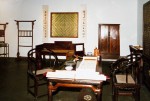 The underground part of the Shanghai Museum also has some courtyard gardens that imitate authentic Chinese traditions. Although these are hidden deeply underground, their architecture and environment seem light and airy.
The underground part of the Shanghai Museum also has some courtyard gardens that imitate authentic Chinese traditions. Although these are hidden deeply underground, their architecture and environment seem light and airy.
Address: Shanghai, Peoples Great Road, #201
Taipei Palace Museum
Address: Taiwan, Taipei City, Shilin Wai Shuangxi Zhishan Lu Er Duan, #221
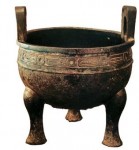 (a kind of ancient vessel)” width=”83″ height=”90″ />The Taipei Palace Museum is located in the northwestern part of Taipei City, facing Shuangxi Park and surrounded by verdant trees and rolling hills. The palace was constructed as a replica of the Beijing Palace Museum. It has an area of more than 10,000 square meters and is grand and imposing in character. Approximately some 620,000 historical items and works of art are stored here, in a magnificent four-storied building. The construction of the Taipei Palace Museum was begun in 1962 and completed in the summer of 1965. Some 240,000 of the items that are kept here originally belonged to the Beijing Palace Museum.
(a kind of ancient vessel)” width=”83″ height=”90″ />The Taipei Palace Museum is located in the northwestern part of Taipei City, facing Shuangxi Park and surrounded by verdant trees and rolling hills. The palace was constructed as a replica of the Beijing Palace Museum. It has an area of more than 10,000 square meters and is grand and imposing in character. Approximately some 620,000 historical items and works of art are stored here, in a magnificent four-storied building. The construction of the Taipei Palace Museum was begun in 1962 and completed in the summer of 1965. Some 240,000 of the items that are kept here originally belonged to the Beijing Palace Museum.
In 1949, 3,824 crates of objects were moved to Taiwan. Among these were the great treasures of ‘hua-xia,’ a term that also means China, but in a more comprehensive cultural sense, including Shang and Zhou bronzes, jades, works of calligraphy from Jin and Tang dynasties onward, paintings from Tang and Song dynasties onward, ceramics from famous kilns from Song and Yuan dynasties onward, bamboo items, rare books, documents from the Qing dynasty, as well as sculptures, jades, lacquer works, enamels, and so on.
Most of the items on display are shown in the main building of the museum.  This building is divided into four levels, with the main entrance being on the second floor. The great hall of the second floor has a bronze bust of Sun Zhongshan (Sun Yatsen), made as a replica of the one in Nanjing at Sun Yatsen’s tomb. All around this sculpture hang very famous paintings and works of calligraphy; in the corridor leading to Sun Yatsen are two of the most famous long scrolls in the history of Chinese art.
This building is divided into four levels, with the main entrance being on the second floor. The great hall of the second floor has a bronze bust of Sun Zhongshan (Sun Yatsen), made as a replica of the one in Nanjing at Sun Yatsen’s tomb. All around this sculpture hang very famous paintings and works of calligraphy; in the corridor leading to Sun Yatsen are two of the most famous long scrolls in the history of Chinese art.
Several national treasures are on the must-see list for visitors. Among these is the Mao Gong ding dating from Western Zhou, unearthed during the latter years of the Qing dynasty in the Daoguang reign (1850) in the province of Shaanxi. The height of this ding is 53.8 centimeters and its diameter is 47.9 centimeters. It has three legs or feet and two upright handles or ears. Its ornamentation is very simple as is the exterior. On the inside of the Ding is an inscription of 491 characters – the longest inscription of any known Chinese bronze.
A large number of calligraphies and paintings by famous painters are exhibited in the Taipei Palace Museum. These include Li Gonglin (1049-1106, notable Song-dynasty painter), Chen Juzhong (years of birth and death unclear, a Southern-Song painter), Qiu Ying (around 1509-1551, a Ming-dynasty painter), Wang Hui(1632-1717, an early Qing-dynasty painter), Fan Kuan (around 950-1027, Song-dynasty painter), Guo Xi (1023-around 1085, Song-dynasty painter), Wang Xizhi (303-361) and so on.
The Taipei Palace Museum also contains a number of famous items of thescholar’s studio. Among these the most representative is the inkstone of the Song-dynasty Su Dongpo (1037-1101), the northern Song calligrapher and literati figure, also the inkstone of Zhao Mengfu (1254-1322), the famous Yuan-dynasty calligrapher. The permanent display of the Taipei Palace Museum contains twenty thousand objects. These are rotated once every three months. Every ten years is a full cycle, so that even rare objects can be exhibited and seen by everyone.
Palace Museum
Address: Beijing, Jingshan Front Street, #4 (Jingshan Qian Jie, #4)
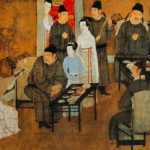 The Palace Museum is situated in the center of Beijing, the capital city of China. It was established on October 10, 1925, and is China’s largest museum.
The Palace Museum is situated in the center of Beijing, the capital city of China. It was established on October 10, 1925, and is China’s largest museum.
The museum is also known as the ‘Purple’ Forbidden City in Chinese, or the Forbidden City as it is commonly known in English. It covers 720,000 square meters and was the imperial palace for a succession of twenty-four emperors and their dynasties during the Ming and Qing periods of Chinese history. The museum is also China’s largest and most complete architectural grouping of ancient halls. Construction was begun in 1420, the eighteenth year of Yongle, so that the site has existed for the past 580 years. More than 70 halls of various sizes, containing more than 9,000 rooms, comprise the Forbidden City. These halls are aligned along a north-south axis, and extend out on either side in an east-west symmetry. The central axis not only passes through the Purple Forbidden City, but extends south to Yongding Gate and north to the Bell and Drum Towers, for a length of some eight kilometers.
This passage through the entire city of Beijing symbolizes the centrality of the imperial power: the imperial seat is at the very center of this line. The architectural design lines up the buildings in neat array and with imposing scale. In a concentrated form, this assemblage expresses China’s artistic traditions in the setting of China’s unique architectural style.
Entering the Forbidden City from Tian’an Men, one first moves straight through the Duan Gate to arrive at Wu Men, or the great Wu Gate. The popular name for Wu Men is the Five Phoenix Tower; this is the front entrance to the Purple Forbidden City. Going through Wu Men, spread out before one is a broad courtyard with the twisting course of the Jinshui Creek (Gold Water Creek) passing from west to east like a jade belt. Five marble bridges have been constructed over this waterway. Passing through the Taihe Gate to the north of the bridges one reaches the core of the Purple Forbidden City, the famous three great halls called Taihe Hall, Zhonghe Hall and Baohe Hall.
Taihe Hall is 28 meters high and occupies a space of around 2,380 square meters. It is the largest hall in the Palace. A red-lacquered dais around two meters high sits in its center, on which is placed a golden lacquered and carved dragon throne. Behind the throne is a screen carved with dragons and on either side of the dais are six great golden pillars with vigorous golden dragons coiling up them. In the recessed ceiling well above the throne is an extremely large coiled golden dragon, with a silvery pearl suspended from its mouth. The Taihe Hall was the location of the Emperor’s most important ceremonies, such as his own inauguration, his birthday, New Years, the arrival of winter, and so on.
Behind the Taihe Hall lies the Zhonghe Hall. This is a square hall with four ridge poles along the roofline that unite at the top in a large, round, gilded topknot called a baoding. The profile of the building is extremely beautiful. When the Emperor was about to officiate at important ceremonies, he would first rest in this building and receive visits of his various Ministers.
Behind the Zhonghe Hall is the Baohe Hall. In the Qing dynasty, every New Year’s Eve, the Emperor would hold a great banquet in this hall. This also was where the highest exam of the Ke-ju exam system was held. Emerging from the Baohe Hall and following the stone stairs downwards one arrives at an open rectangular courtyard. This space divides the Purple Forbidden City into front and back. To the south of the square are the three main Halls and, to east and west of them are the Wenhua Hall and the Wuying Hall. These are commonly called the ‘Outer Court,’ where the Emperor primarily conducted affairs of state. To the north of the square, inside the Qianqing Gate, was the Inner Sanctum. In the Qing dynasty, this is where the Emperor and his Empresses and Concubines lived. The main buildings include the Qianqing Palace, the Jiaotai Hall, the Kunning Palace, and six palaces to east and west. The Qianqing Palace was at one time where the Emperor slept. During the Qing dynasty, however, the emperors used this as a place of daily administrative affairs. Later emperors also met foreign emissaries here. Behind the Qianqing Palace is the Jiaotai Hall, which is where memorials to the Empress were conducted and where she received congratulations on her birthday. It also is where the Qing dynasty’s twenty-five ‘treasures’were kept, the twenty-five seals by use of which the Emperor manifested his rule. Behind the Jiaotai Hall is the Kunning Palace, which was originally a sleeping chamber for the Empress. Later in the Qing dynasty it was made into a place where offerings to gods were made and also where the Emperor was married.